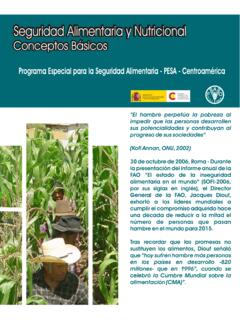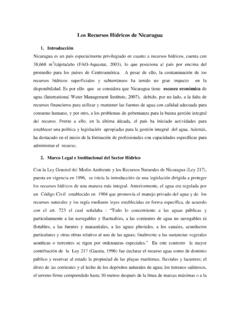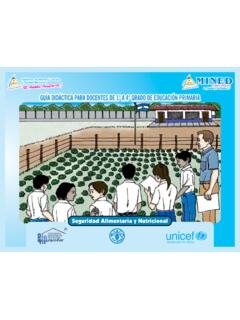Transcription of SEED PRODUCTION MANUAL - Food and Agriculture …
1 I seed PRODUCTION and Training MANUAL by Lambert Delimini FAO - 12/05/2012 GCP/SIL/032/GER 2012 LAMBERT DELIMINI 10/16/2012 seed PRODUCTION AND TRIANING MANUAL FAO/GERMANY COOPERATIVE PROGRAMME For MINISTRY OF Agriculture , FORESTRY AND FOOD SECURITY ii seed PRODUCTION AND TRIANING MANUAL Chapter One: seed PRODUCTION of Selected Cereal and seed Chapter Two: seed seed PRODUCTION Starting With seed Rules for Certifying Rice seed (Self Pollination Crop).
2 11 Maize seed Sorghum seed Bean seed Groundnut seed Chapter Three: Field Inspection Techniques: Procedures and The Procedures for Inspection at Specific Growth Chapter Four: Roots and Tuber Planting Material PRODUCTION , Procedures for Cassava and Sweet Cassava Potato Chapter Five: Principle of seed Condition/Processing: Shelling, Cleaning and Chapter Six: seed Sampling and Chapter Seven: seed Testing and Certification: Concept, Principle and iii Chapter Eight: seed Quality Control and Certification OECD FAO Quality Declaration Chapter Nine: Importance of Record Record TABLES Table 1: Basic Characteristics of popular rice varieties grown in Sierra Table 2: Varietal Characteristics of the Ghana Table 3: Field Table 4: seed Table 5: Specific Table 6: seed Standards.
3 20 Table 7: seed Table 8: Groundnuts seed and certification Table 9: Standards For Inspecting And Certifying Cassava Planting Table 10: Crop: Sweet Table 11: Standards for Laboratory Tests, A Pre-basic seed B Basic seed C Certified seed D Commercial Table 12: Type of Standards to be 1 seed PRODUCTION and Training MANUAL by Lambert Delimini FAO - 12/05/2012 PREFACE Plant breeding activities lead to the development and release of improved crop varieties. The purpose of releasing improved crop varieties is to increase productivity and overall crop PRODUCTION to anchor food security.
4 Food security is achievable through mass utilization of varieties which are high yielding, resistant/tolerant to pests and disease pressures, ecologically suitable, tolerance to drought and soil mineral toxicity. To further the goal of varietal releases, farmers must have access to and benefits from the use of varieties through agricultural intensification where improved seed is backed by good agronomy, fertilizers and pesticides application under conservation Agriculture . Dissemination of improved crop varieties to famers under the formal sector is generally channeled through seed systems, institutions and agencies.
5 There are different types of seed development and certification systems the choice of which may depend on national agricultural and seed policies, level of development of the national seed industry and the financial status of farmers. Each system has its goals and objectives to accomplish. The different seed systems vary from seed projects, parastatal organizations, private companies, to public/private/partnership enterprises. Each level depends on the national agricultural development agenda and the objectives to achieve. The Government of the Republic of Sierra Leone, in collaboration with the Republic of Germany embarked on seed industry initiatives about 30 years ago, with the establishment of a seed Multiplication Project to ensure the development and dissemination of improved quality rice seed to farmers.
6 This evolved into a seed Multiplication Unit. The focus at that time was to ensure the availability of improved high quality rice seed to farmers. With the advent of the dreadful war in the 1990s, operations of the unit were interrupted leading to a complete collapse of the activities of the unit. As a consequence, seed of all kinds was scarce and rice seed in particular which is a major staple food of the country was unavailable. To accelerate the realization of food security, the GOSL has restructured the national seed industry with a private/public/partnership enterprise engagement in the seed delivery apparatus as an option.
7 The public/private/partnership option is to engender competition among seed enterprises in the seed sector, for a more efficient delivery of a wider range of improved crop varieties and planting materials. The final goal is to eventually develop a seed system which will be self sustaining, profitable and capable of delivering the right type of seed at a competitive price. Apart from the seed Multiplication Program (SMP), which is being nurtured by the Government of Sierra Leone and the Food and Agriculture Organization of the United Nations ( FAO) through the seed Enterprises 2 Enhancement and Development ( seed ) Project, there are now, other seed enterprises, some of which are supported by other Programs and Projects such as the Program for Agricultural seed Systems(PASS) and the Agricultural Revolution for Africa (AGRA)
8 To maximize profitability and services of seed enterprises to farmers and seed users, some of the enterprises have now expanded their product lines to include other crops such as maize, cassava, beans and sweet potatoes. To achieve the objective of providing quality seeds to farmers, requires capacity building in seed PRODUCTION technology, marketing, business management and other elements that require the involvement of key stakeholders and strategic partners. Capacity building in the seed PRODUCTION component, covers common staple cereal crops and pulses such as rice, maize, beans and groundnuts.
9 It also includes the staple vegetative planting materials such as cassava and potatoes. The purpose of the MANUAL is to serve as a reference training MANUAL for technical staff, seed producers and a contribution to the development and progress of the seed industry in Sierra Leone especially with the private sector in view. It is also in partial fulfillment of the TOR of the seed PRODUCTION consultant. 3 CHAPTER ONE: seed PRODUCTION OF SELECTED CEREALS AND PULSES Introduction: Rice is the most important staple crop in Sierra Leone.
10 It is consumed by approximately 90% of the population and per capita consumption is estimated at 80kg per person annually. It is grown extensively under five major ecologies, which are upland, mangrove swamp, inland swamp, riverain grass land and boliland. Upland rice is grown throughout the country. Rice PRODUCTION in inland valley swamps is widely dispersed also, but the PRODUCTION of mangrove swamp rice, riverain grassland and boliland is restricted to fairly well define ecological areas of Sierra Leone.. Rice research in Sierra Leone began in the 1950s and by the close of the 1970s a considerable number of rice varieties mainly of the ROK series had been released by the Rice Research Institute at Rokupr, now the SLARI, for the various ecologies.






